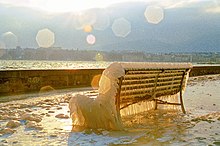Slippery winter


Slippery winter (also slippery roads in traffic ) or black ice occurs when a layer of ice or other sliding layer forms on the ground. This is a major traffic and accident risk, especially on the road surface and other walking structures .
Causes and forms
There are various causes for the slippery winter:
- When there is slippery snow , existing snow is removed by pressure, e.g. B. by cars or pedestrians, pressed together to form a smooth layer. This layer becomes particularly smooth when it thaws and then freezes again.
- Even freezing slush results in packed snow.
- When the water (puddles) on the road freezes, one speaks of slippery ice (freezing wetness). This can be caused by a cold snap, but very common and treacherous is snow next to the roadway that has melted from the sun and freezes over again in the evening or even in the shade.
- Slippery frost occurs when the temperature of the road surface is below the dew point and thus humidity or fog freezes. Since bridges cool down more at night, the risk of icy frost is particularly high here, as is the case in other places exposed to wind. In the USA there are specially warning traffic signs .
- In freezing rain , also known as lightning ice , fresh precipitation freezes when it hits the ground. When normal raindrops freeze immediately on the frozen ground, this is known as freezing rain (technically, rough ice ). Supercooled rain (technically clear / black ice ) is caused by supercooled raindrops, which suddenly freeze when they hit the ground. The difference is that the latter occurs at temperatures above zero degrees and is much more difficult to predict than the former because the cause is minus temperatures in higher air layers.
- The same effect can occur when it rains inside in little deep snow, but not enough to wegzu him apern , such as light drizzle : Then the snow first converts in Harsch and then in compact ice.
- Slippery mud can occur , in spite of the corresponding traffic safety obligations , especially in rural areas when wet soil residues are brought from agricultural areas onto a street.
- Gischteis is a special form of the coast, here when it is very cold and stormy, precipitation does not freeze in the actual sense, but the surf spray . This corresponds to the problem of ship freezing in the sea.
In addition, there are forms that are considered to be slippery in traffic from a traffic perspective, but are not ice formation:
- Unfrozen slush leads to slip effects when it occurs before blocking tire (see FIG. ABS jams) and the forming wedge of slush characterized slides on the road surface. This danger can also arise when winter road clearance is carried out on inadequately cleared road surfaces.
- Slippery salt occurs because the hygroscopic road salt forms moisture from the air. Then even roads that appear apere and dry can become slippery.
In general, the danger of slippery winter starts at +4 ° C. This is where modern vehicles with temperature sensors and on-board electronics begin to issue a slippery road warning.
Warning signs and other warning notices do not exempt a person responsible for road safety or a person responsible for slippery roads from the obligation to combat slippery roads, unless otherwise regulated by law. Most of the municipal statutes oblige the residents and / or the winter service to remove winter slipperiness between 7 a.m. and 8 p.m., on the weekend a little later in the morning.
An ice warning system is a device for recording or forecasting black ice or the risk of black ice on roads. Such systems are installed on many high-level roads (expressways and motorways).
The so-called " peasant slippery ice " is a form of slippery road which, contrary to its name, has nothing to do with ice in the sense of frozen water, but is caused by road pollution.
Web links
Individual evidence
- ↑ a b c In meteorology, a distinction is sometimes also made between the two terms black ice or ice slippery as primary ice formation and winter slippery as secondary (for example due to the solidification of snow). For example in: Joachim Blüthgen, Wolfgang Weischet: Allgemeine Klimageographie. Volume 2 by Wolfgang Weischet (Ed.): Textbook of general geography . Walter de Gruyter, 1980, ISBN 3-11-006561-4 , deposits section . P. 283 ( limited preview in Google Book search); or in: Glätte , DWD Wetterlexikon .
- ^ Smoothness , DWD Weather Lexicon .


